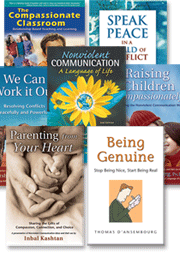Therapeutic Communication ... continued
For the next few years, I avoided angry patients as much as possible. I performed my duties as a nurse cheerfully and efficiently and thought I was doing a great job. I was puzzled as to why I wasn't receiving more appreciation. After all, I constantly sacrificed my own needs to meet the needs of patients and the administration, and I was efficient, tireless, strong, and had excellent nursing skills.
I worked much of the time in intensive care units where I was free to apply my skills and knowledge to keep patients alive, and where I didn't have to communicate much because the patients were often unconscious or intubated. I often felt distressed because I wanted more respect and acknowledgment, but no matter how hard I tried, these needs remained unfulfilled.
It was not until I began taking workshops in Nonviolent Communication that I began enjoying working with the "whole" patient. I soon discovered that before I could deal effectively with angry patients, I had to first receive accurate understanding (empathy) for what caused the fear reaction in me that led me to avoid their anger.
While learning Nonviolent Communication my own childhood pain in relation to my angry parents was heard accurately and clearly for the first time in my life. I was not told, as I had been in the past, to forgive my parents or that I should not have these feelings because my parents did the best they could. Instead, I learned how to empathize with my own feelings and needs, and how to identify ways I might have these needs met.
Next, I learned communication techniques for listening to what occurs inside a person and for expressing what was going on inside me. I had never learned how to deal with feelings because my family avoided expressing them until they built up and then exploded with anger.
Giving and receiving empathy became my passion. A whole new world opened up to me, and my view of the world changed. Thought patterns that kept me stuck in a state of depression began to shift. My relationships changed drastically and I began enjoying my work as a nurse.
After learning these skills I began to empathize with my patients and I noticed how much they appreciated me and how much calmer they felt after having someone listen to them express how they feel and to guess what they might need. I realized how in the past I had blocked communication by offering advice or trying to fix the problem when I heard someone express a feeling.
It was a relief to me to know that I didn't need to do anything when someone expressed feelings, and I became aware of how therapeutic it was for the patient when I was just present to share whatever was going on inside them.
The way we are taught to communicate in our society seems to be harmful to esteem and destroys intimacy. I saw an example of this type of non-therapeutic communication on national television recently. A woman was in the emergency room with her baby who had been injured when the car overturned.
Woman: I only took her out of her car seat because she was choking.
Nurse: You should never take a baby out of a car seat while the car is moving.
Woman: When your baby is choking you just don’t stop and think.
Nurse: You should pull the car over and stop first.
Woman (crying and sobbing): But she was choking.
Nurse: Now, you need to calm down, you need to be calm for your baby because babies can sense when their mothers are upset.
I felt embarrassed for the nurse when I watched this and sad that the woman didn't get the empathy she needed. If the nurse had used empathy instead of judgment and advice, she would have learned what really was happening with this woman and could have offered the appropriate intervention to prevent such a tragedy from recurring.
If therapeutic communication had been used, the following dialogue may have occurred:
Women: I only took her out of her car seat because she was choking.
Nurse: Are you feeling scared that you are being judged for what you did?
Woman: Ever since this happened people have been acting like the whole thing is my fault.
Nurse: Are you angry about that and need some understanding about all the factors involved in making this happen?
Woman (sobbing): Yes, I feel so guilty already that when everyone is putting all the blame on me and I just feel horrible.
Nurse: When you see what happened to your baby and hear people’s reaction to it, I wonder if you feel ashamed?
Woman: Yes, I'm scared I'm not a good mother. It was so stupid of me to take her out of her car seat.
Nurse: You really regret taking her out of the car seat while the car was moving and wish you had done something else.
Woman (calmer now): Yes, I wish I knew how to be a better mother. I would do anything for my baby. I love her so much.
Nurse: Would you like information about community resources available to help you and your baby?
Woman: Yes, that would be helpful.
In the first example, the woman remained defensive and scared throughout the communication. This type of communication created such a defensive reaction in the woman that it is doubtful she would have been receptive to hearing about community resources that could help her. She may have lacked the tools she needed to be an effective parent, and without help, her baby may have ended up back in the emergency room.
To be an effective communicator we must be willing to let go of judgment, accept our own imperfection, and have a desire to connect with others' feelings and needs.
The trick to learning empathy is to practice. Stick your neck out and try using this empathy the next time you come across a patient who is in distress. You may find that your whole experience of nursing changes for the better.
Melanie Sears, MBA, RN is the author of Humanizing Health Care
Humanizing Health Care and its companion workbook, Choose Your Words, a Registered Nurse with 30 years experience working within the health care industry, and is an official trainer for The Center for Nonviolent Communication. Melanie has worked in most areas of health care and has used NVC to connect with her patients and to transform the medical system's Command and Control culture to one of Partnership and Accountability. She is an active member of Northwest Nonviolent Communication in Seattle, Washington. You can contact her through her website at: www.DNADialogues.com
Keep learning these vital communication skills with these books and training resources:
This Month's Specials:
Every Day Book Package Specials:
-
NVC Starter Kit Book Package - Save 40%-50% on this book package every day from PuddleDancer Press
-
NVC Marshall B. Rosenberg, Ph.D. Book Package - Save 45%-55% on this book package every day from PuddleDancer Press







